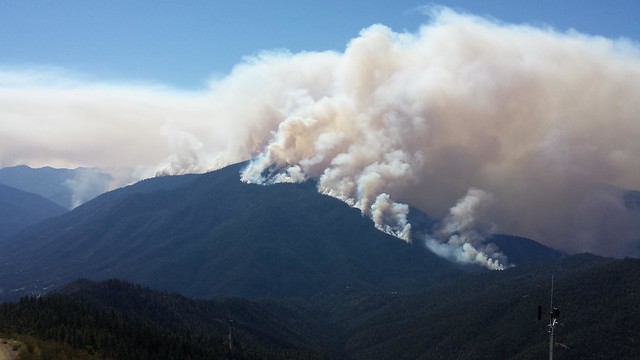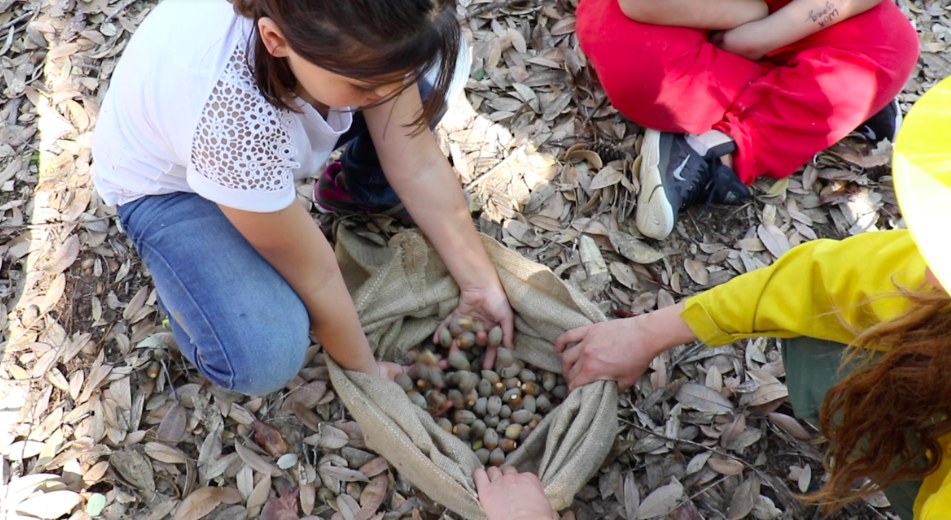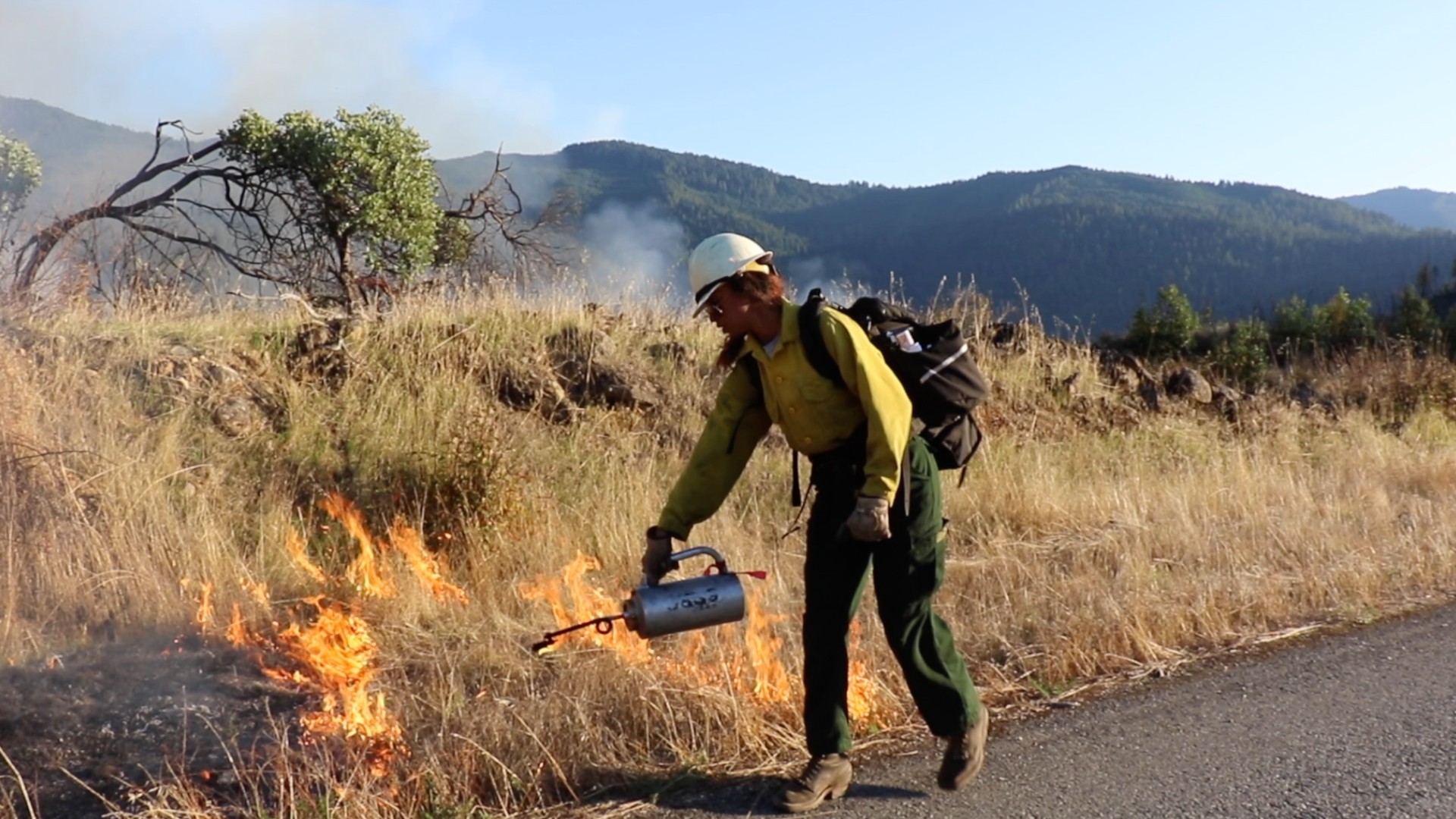More and more land in California is going up in flames. The area in the state burned by wildfires has increased by a factor of five since 1972, according to a recent study, which identified human-caused warming the likely culprit.
So what’s to be done?
The Karuk Tribe wants to fight fire with fire.
This summer the tribe, one of the largest in the state, released a climate-adaptation plan that calls for a return to a more natural fire regime. According to the plan, using prescribed burns at appropriate times of the year in place of the current policy of fire suppression would reduce the possibility of high-severity fires, which have proven deadly and costly for California in recent years and are expected to worsen as the climate warms.
“Climate adaptation is about restoring human responsibilities and appropriate relationships to the natural world,” says Bill Tripp, deputy director of Karuk Natural Resources Department and a co-author of the plan.
Wildfires have always been a part of the ecology of California, and “Karuk people have long been part of the ecosystem,” says Tripp. Prescribed burning, in particular, has been a key part of cultural practices of Indigenous people for millennia. As the Karuk climate plan explains, “Due in part to these thousands of years of purposeful fire management, the forests of this region are ecologically dependent on fires that are low in heat production, or ‘cooler’ fires.”
But much of that historic burning was snuffed out with the arrival of white settlers and a century-long U.S. government policy of fire suppression. In the Karuk territory and many other areas of the West, ecosystems are adapted to burn frequently, but suppression disrupts those natural processes. Instead, forests end up with dense, homogenous stands of trees, meadows are crowded out and dead materials accumulate on the forest floor — all of which can contribute to high-intensity fires that are now being supersized by warmer, drier forest conditions.
For the Karuk this has consequences for everything from food to culture. As the plan explains, “The exclusion of fire has led to radical ecological changes including high fuel loads, decreased habitat for large game such as elk and deer, reduction in the quantity and quality of acorns, and alteration of growth patterns of basketry materials such as hazel and willow.”

Many scientists, as well as tribes, are calling for more controlled burns, but efforts for the Karuk to bring fire back to the land — and better increase their resilience in the face of climate change — are complicated by issues of sovereignty and lagging policy.
Contested Land
The Karuk people hail from the rugged and remote Klamath-Siskiyou Mountains in Northern California, along the Klamath and Salmon rivers. Most of their aboriginal territory of just over 1 million acres is currently managed by the federal government as national forest, although the tribe never ceded the land.
Instead the tribe’s “heavily timbered, mineral-rich homeland” was “taken by the United States without ratification of its treaties negotiated in 1851,” historian Stephen Dow Beckham wrote in an article two years ago. With the promise of a reservation never fulfilled, the tribe has virtually no land base.
Tribal members are still dependent on the resources from the nearby forests for food, fiber and cultural practices, but decisions about how that land is managed falls to outside agencies, like the U.S. Forest Service.
That leaves the tribe with little control over its own future. The tribe is concerned that poor land management, combined with climate change, increasingly puts them at risk and threatens their cultural resources.
The risks have already started to materialize: Temperatures in the region have increased 2 degrees Fahrenheit since 1931, and the tribe has already seen more variable precipitation, decreased snowpack, earlier snowmelt, less spring runoff, drier fall weather, a longer fire season, and more insect pests and pathogens — including Phytophthora ramorum, which causes “sudden oak death.” All those things are expected to worsen with warming temperatures, and the ecological changes could affect other species of cultural significance for the tribe, including chinook salmon, Pacific lamprey, beavers, Pacific giant salamander, tanoaks, evergreen huckleberry and elk. Some species already face compounding environmental pressures from fire suppression, dams, logging and water diversions.
But the biggest concern is in the increased risk of high-severity fire, which can damage homes and infrastructure, create public-health risks, destroy cultural resources and diminish water quality. Big wildfires have already hit close to home for the Karuk. In 2008 the massive Klamath Theater Complex Fire, a conflagration that united 11 separate blazes, burned for three months in the region and consumed more than 190,000 acres. Then in 2014 the Happy Camp Complex Fire burned 134,000 acres, ripping through the heart of Karuk territory and prompting the tribe to turn its community center into a refuge for residents forced to evacuate their homes.

The Karuk’s climate-adaptation plan is an effort to shift the management dynamic and builds on some recent cooperative work among the Forest Service, the Karuk and other local groups.
“This plan is years in the making and we’re hoping we’ll be able to actually start to change the paradigm in the way fire is managed in Karuk country,” says Tripp.
The Karuk’s plan is also part of a growing effort from dozens of tribes across the United States to assess climate vulnerability and build adaptation plans, although each tribe faces unique challenges, especially tribes without federal recognition. (The Karuk have federal recognition, a relative rarity in California.)
It’s a trend that’s deeply needed.
“Indigenous people are disproportionately impacted by the changing climate as they lack the financial resources to build new infrastructure,” says Kari Norgaard, associate professor of sociology and environmental studies at the University of Oregon and a co-author of the Karuk plan. “But for the Karuk, their vulnerability to climate change is also a function of state policy — the Karuk’s ability to do what they want to do is reduced because of those structural conditions.” Basic management decisions regarding land-use, logging and fire policy are out of their hands.
At the same time, says Norgaard, tribal members possess a wealth of information on the management of local ecosystems that should play a leading role as the region plans for how to cope with climate impacts.
“Native American tribes and native nations have been at the forefront of a lot of climate work, whether that’s in the-street-protests or putting up solar panels or doing climate adaptation plans,” she says.
But daunting challenges remain.
“One of the biggest obstacles is the sense that indigenous knowledge is sort of dead or not valid,” says Norgaard, who has conducted collaborative research projects with the Karuk since 2003. “Many people just do not understand how much indigenous knowledge about fire use is really a modern science still today.” Western scientists have increasingly called for the incorporation of traditional ecological knowledge into new plans for reintroducing natural fire regimes back to the landscape.
The Science of Burning
Indeed the Karuk’s call for more prescribed burning is supported by a growing body of scientific studies.
“Prescribed fire is one of the most widely advocated management practices for reducing wildfire hazard and has a long and rich tradition rooted in indigenous and local ecological knowledge,” Crystal A. Kolden, an associate professor in the Department of Forest, Rangeland and Fire Sciences at the University of Idaho, wrote in a report in the journal Fire. “The scientific literature has repeatedly reported that prescribed fire is often the most effective means of achieving such goals by reducing fuels and wildfire hazard and restoring ecological function to fire-adapted ecosystems in the United States following a century of fire exclusion.”

(Photo by Jenny Staats)
Despite those scientific findings, the actual practice of prescribed burns lags greatly, as does funding. A recent report from Climate Central found that federal funding for prescribed burns is a fraction of what’s allocated for suppression.
And that’s become obvious on the ground. Kolden’s research revealed that prescribed burning hasn’t increased across the western United States in the past 20 years. In some places it has actually decreased. Most of the prescribed burning happening in the country, she found, was in the Southeast.
That worries Bill Tripp.
“When I hear the agencies talking about having a 97 percent success rate of suppressing fires, it makes me think that 97 percent of what should have been burning isn’t,” he says.
Kolden’s report suggests that we need a larger cultural shift and better public education about prescribed fires and their role in reducing wildlife risk. “Without such a shift, more catastrophic wildfire disasters are inevitable,” she wrote.
And that’s at the crux of the Karuk’s intention with their plan, a big part of which is working on increased engagement and public education, as well as more “interjurisdictional coordination” — allowing the Karuk to help drive management policy.
But even if all that goes well, there are still challenges to returning low-intensity fire to areas that haven’t been burned in 100 years.
“Just the cost alone is going to be quite expensive, and then there are issues of workforce development and training,” says Tripp. “It’s not just about burning a certain number of acres. It’s about how you put fire on the ground — it needs to be done right.”
There’s also the public perception or “social license,” he says. Twenty years ago, the majority of people believed that all fire was bad, says Tripp. But he’s seen that mentality shift in recent years. More and more people are learning that fire can be used beneficially — although it can be still be a tough sell in a state that has seen recent wildfires claim dozens of lives.
But the Karuk are hoping to convince people through example. The tribe has been working closely for years to develop a plan with the Six Rivers National Forest on a 5,500-acre demonstration project that will allow them to begin some restoration and prescribed burning in the national forest. They hope to carry the lessons learned from that work to further efforts, says Tripp.

“I’m hoping that we could end up getting to a place to where we can just all work together to make this all happen and try to mitigate these effects of climate change the best we can and protect as many of the species as we can that may be in peril,” he adds.
Norgaard says she feels that efforts like this can help people see that the threats of climate change and wildfires don’t have to leave people feeling disempowered.
“There is a lot we can do,” she says, “and we need to be doing it now.”
![]()


